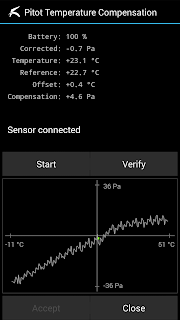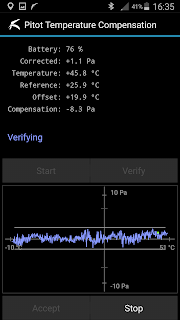Originally written in English
This chapter refers to the usage of the BlueflyVario V12 with Pitot airspeed extension. If you want to use this optional extension, please check first the Bluefly Vario blog.
For V11 there is currently no way to properly compensate the residual temperature drift of the Pitot sensor, so you can only rely on the manufacturer's pre-compensation.
There are different V12 firmware versions, please make sure that your V12 firmware is up-to-date. I am using BlueFlyVario_12.M16 (BlueFlyVario_Bluetooth_USB_12.416.hex).
The Pitot extension uses the well known differential pressure sensor 4525DO-DS5AI001DP. It is produced by TE Connectivity / Measurement Specialities, and it can also be obtained from Mouser.
Unfortunately these ICs (at least the ones I got) have a residual temperature drift which cannot be ignored at the low speeds we are flying with (see the note at the end of this section). The drift curve is basically different for each single sensor coming from the factory. For this reason, TotalVario has a built-in temperature drift analyses and compensation feature.
Before you can reliably use the Pitot sensor, it is very important that you run the residual temperature drift analyses. This is needed even if you fly at rather constant air temperature (about the same altitude), because the DP sensor will start warming up during operation, and because the pod (whatever type) will warm up significantly in sunlight and during operation as well. If you are lucky, you may notice that your sensor chip is already sufficiently compensated by the manufacturer and the drift remains within a few Pa.
During the analyses, the residual temperature drift of the DP sensor is measured and stored.
Like smartphones, the Bluefly Vario uses
a stock LiPo battery. Be aware that these batteries are generally
sensitive to temperature and the battery lifetime may be shortened by
wrong treatment.
You will need a deep freezer and a modern oven with precise electronic temperature control. It must be possible to limit the temperature reliably. Never exceed 50 °C. Possibly you can use a wall heater instead.
NEVER use a hot oven or anything else that you cannot touch with your hands !
Preparations:
- Charge the Bluefly Vario and the smartphone to 100%.
- Run the app and connect the Bluefly Vario.
- The connection must be stable even when you put the box with the Bluefly Vario into the oven or into the deep freezer.
- The box must be placed in the middle of the oven, away from the walls or heater.
Now start a quick test run. Open the [Pitot Temperature Compensation] page and push [Start]. The sensor will be zeroed once again and the measurement will begin.
On top you can see essential data. The current and average differential pressure are displayed in a graph by a moving dot and a line. At the end, the graph will show the temperature drift over the measured range.
If you wait a minute, probably the pressure indicator dot will start to 'draw' the graph because the sensor is warming up slowly. Try to put the Bluefly Vario into the freezer and into the oven, each only for a minute or so, and observe how the graph is drawn. If this works well, the compensation process can start. Push [Abort] if you want to run the full compensation later.
We
need to run a complete temperature cycle over the full range, starting
with a properly zeroed DP sensor at stable, constant room temperature.
We need to cool the sensor slowly down to about -5°C, then warm it slowly up back to room temperature, and finally warm it slowly up to the maximum temperature.
The best results are obtained if the
temperature changes slowly, because for each temperature step multiple
sensor values are read and averaged. Therfore,
- DO NOT put the Bluefly Vario directly from the fridge into the oven or vice versa !!
- NEVER cool the Bluefly Vario down to less than -5 °C !!
- NEVER warm the Bluefly Vario up to more than 45 °C !!
Start with putting the box with the Bluefly Vario into the deep freezer. At the latest when -5 °C are reached, get the box out of the fridge. Do NOT open the box. Wait until temperature is close to room temperature again. Observe how the compensation curve is drawn.
The
same procedure is then done for the upper temperature range
in the oven. Start with the oven switched off! The slower the sensor temperature increases, the better.
At the latest when 45 °C are reached, you should see a nice, complete compensation curve.
Push [Accept] to store it forever. That's it.
You can repeat the
compensation run at any time, but it is normally needed only once for a
specific DP sensor. So far I did not observe any aging effects (over 36
months).
The final compensation curve should look similar to the one I found. The overall slope my differ. Note that I even went from -10 to +50 °. Fortunately the Bluefly Vario, the DP sensor and the LiPo did survive.
In case you have some doubt whether the drift compensation is good, you can use the [Verify] button. Just start and
observe the graph while the temperature changes. Again, a curve for the
residual drift will be drawn, but it should be very small, similar as my result:
Why is it so complicated? - a short explanation
Pitot sensors measure the differential pressure between the static air pressure and the dynamic air pressure caused be the air hitting the Pitot tube in flight. Especially at low speeds, reliable measurement is very difficult, even with modern membrane based precision sensor chips, due to the extremely small differences in the order of magnitude of a few Pascal. In addition the square root dependency between speed and pressure is most critical at low speeds (unfortunately physics works against us here).
Copyright (c) 2021, Bernd Wing*. All rights reserved.


